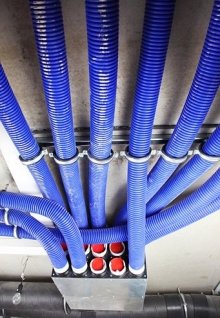Ventilation is very important in an energy-efficient home. The “appropriate” amount and type of ventilation varies from home to home and from occupant to occupant. Different households have different occupancy levels (people and pets), schedules, activities, health concerns, and other preferences that will influence appropriate ventilation systems and operation. Ventilation also helps control moisture, thus reducing the chances of mold growth and structural damage. The American Society of Heating, Refrigerating and Air-Conditioning Engineers (ASHRAE) specifies how a home’s living area should be ventilated in ASHRAE Standard 62.2.
There are three basic ventilation options —natural ventilation, spot ventilation, and whole-house ventilation.
Natural Ventilation
Natural ventilation is the uncontrolled air movement in and out of the cracks and small holes in a home. In the past, this air leakage usually diluted air pollutants enough to maintain adequate indoor air quality. Today, we are sealing those cracks and holes to make our homes more energy-efficient, and after a home is properly air sealed, ventilation is necessary to maintain a healthy and comfortable indoor environment. Opening windows and doors also provides natural ventilation, but many people keep their homes closed up because they use central heating and cooling systems year-round.
Natural ventilation is unpredictable and uncontrollable—you can’t rely on it to ventilate a house uniformly. Natural ventilation depends on a home’s airtightness, outdoor temperatures, wind, and other factors. During mild weather, some homes may lack sufficient natural ventilation for pollutant removal. During windy or extreme weather, a home that hasn’t been air sealed properly will be drafty, uncomfortable, and expensive to heat and cool.
Spot Ventilation
Spot ventilation can improve the effectiveness of natural and whole-house ventilation by removing indoor air pollution and/or moisture at its source. Spot ventilation includes the use of localized exhaust fans, such as those used above kitchen ranges and in bathrooms. ASHRAE recommends intermittent or continuous ventilation rates for bathrooms of 50 or 20 cubic feet per minute and kitchens of 100 or 25 cubic feet per minute, respectively.
Whole-House Ventilation
The decision to use whole-house ventilation is typically motivated by concerns that natural ventilation won’t provide adequate air quality, even with source control by spot ventilation. Whole-house ventilation systems provide controlled, uniform ventilation throughout a house. These systems use one or more fans and duct systems to exhaust stale air and/or supply fresh air to the house.
There are four types of systems:
- Exhaust ventilation systems work by depressurizing the building and are relatively simple and inexpensive to install.
- Supply ventilation systems work by pressurizing the building and are also relatively simple and inexpensive to install.
- Balanced ventilation systems, if properly designed and installed, neither pressurize nor depressurize a house. Rather, they introduce and exhaust approximately equal quantities of fresh outside air and polluted inside air.
- Energy recovery ventilation systems provide controlled ventilation while minimizing energy loss. They reduce the costs of heating ventilated air in the winter by transferring heat from the warm inside air being exhausted to the fresh (but cold) supply air. In the summer, the inside air cools the warmer supply air to reduce ventilation cooling costs. Compare whole-house ventilation systems to determine which is right for your home.
Ventilation for cooling is the least expensive and most energy-efficient way to cool buildings. Ventilation works best when combined with techniques to avoid heat buildup in your home. In some climates, natural ventilation is sufficient to keep the house comfortable, although it usually needs to be supplemented with spot ventilation, ceiling fans, window fans, and—in larger homes—whole-house fans.
Ventilation is not an effective cooling strategy in hot, humid climates where temperature swings between day and night are small. In these climates, however, natural ventilation of your attic (often required by building codes) will help to reduce your use of air conditioning, and attic fans may also help keep cooling costs down.
Call now! 832-661-6154



Recent Comments